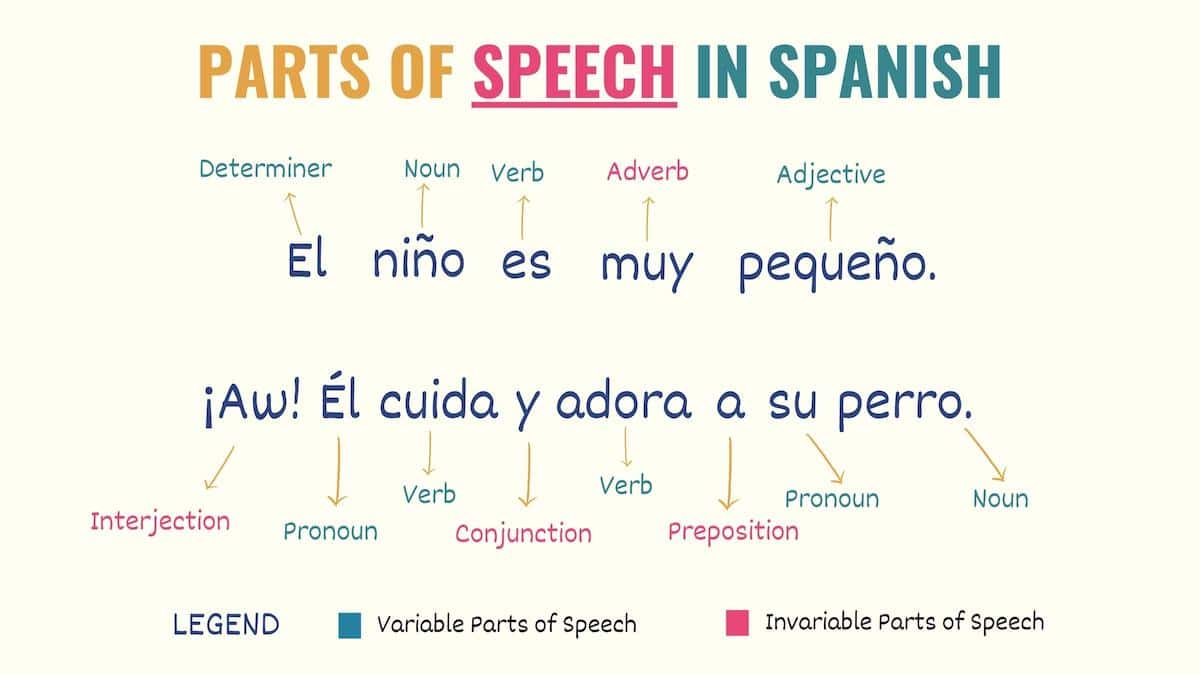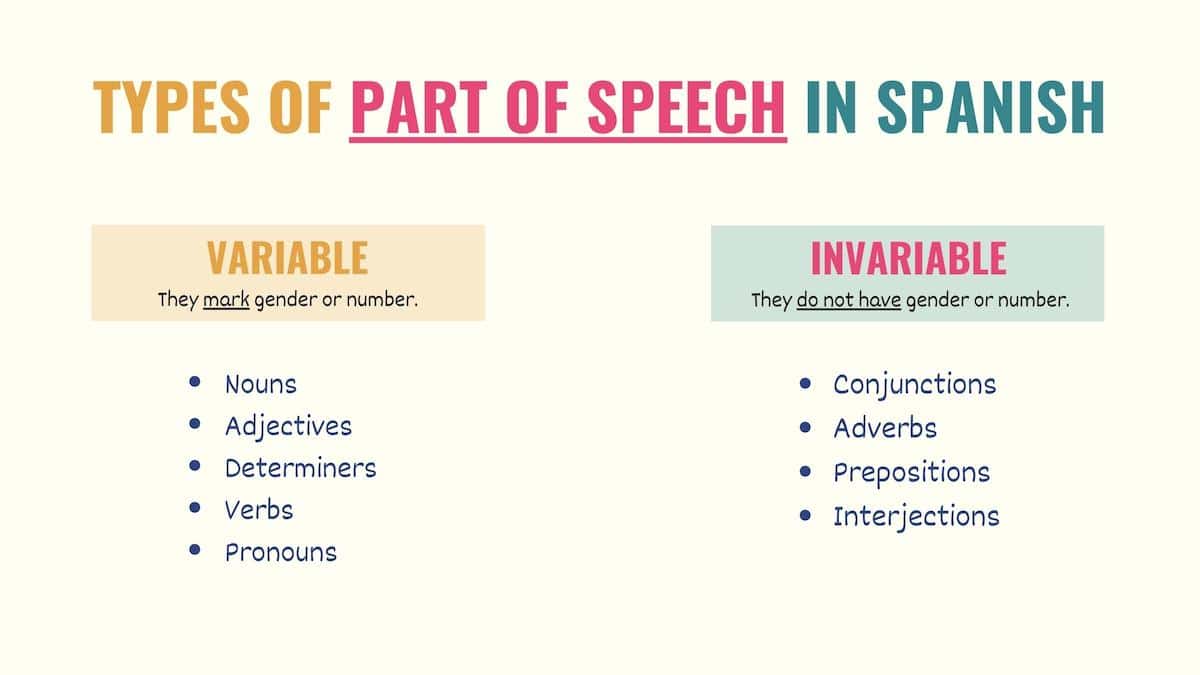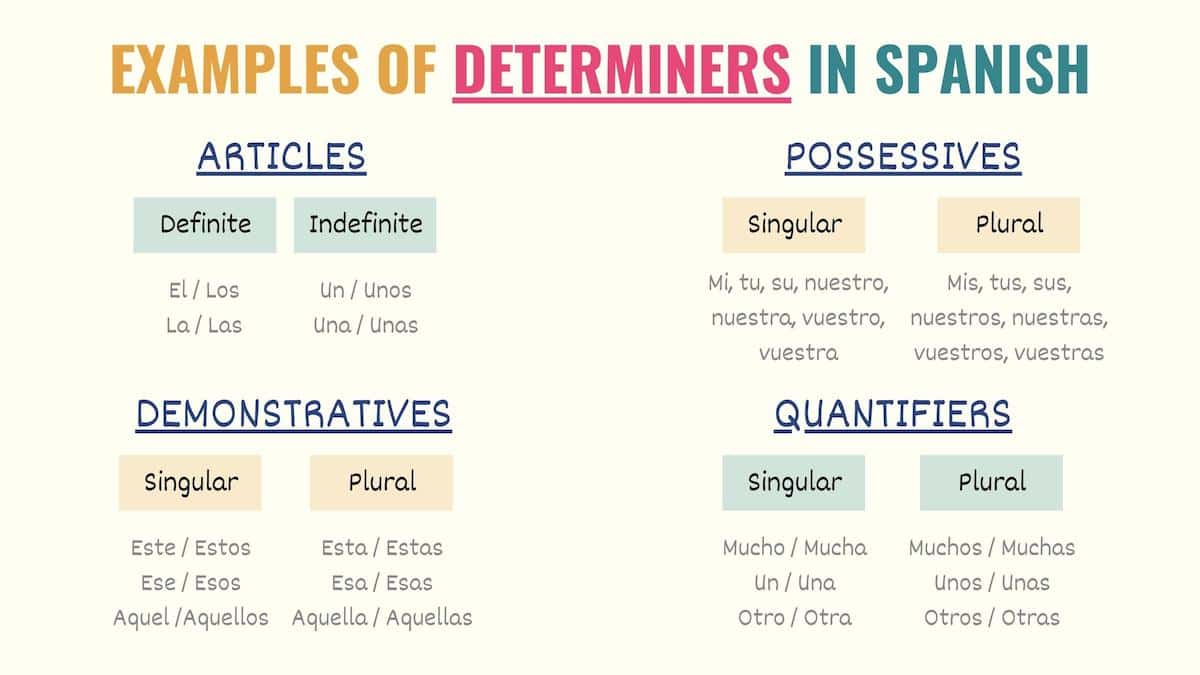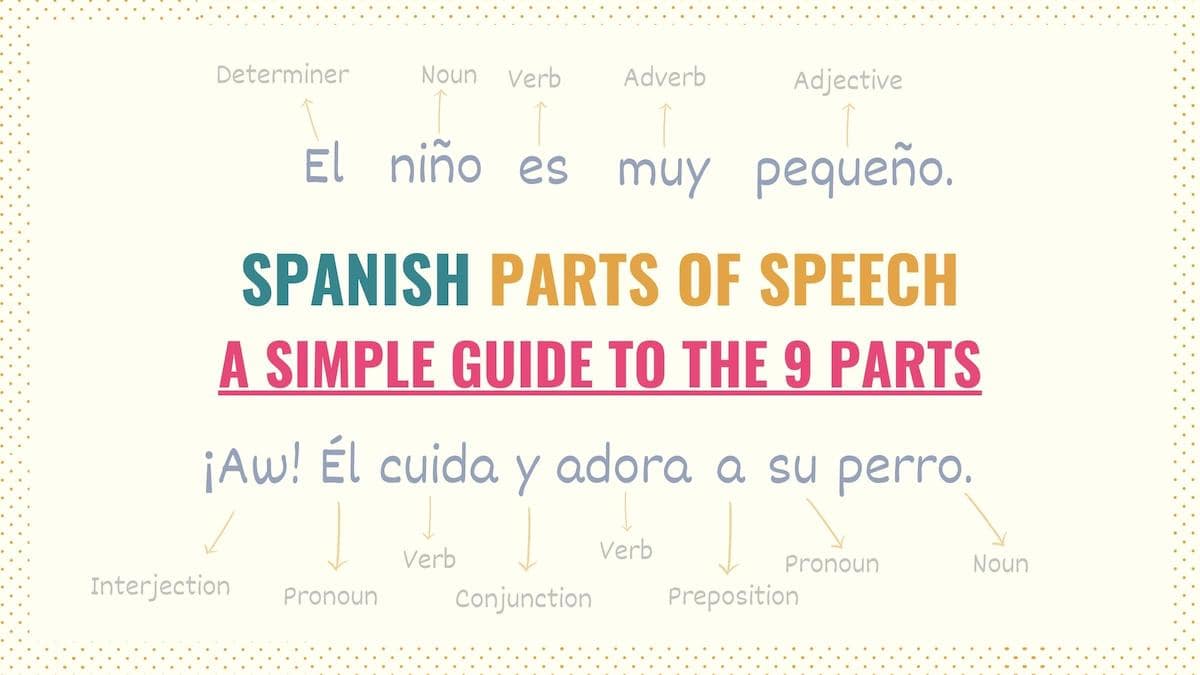Parts of speech in Spanish are the different words we use to form a sentence. In short, they’re the fundamentals of Spanish grammar. So, getting familiar with parts of speech is crucial for articulating coherent sentences.
For that reason, in this guide, we’ll go over the 9 parts of speech in Spanish. Here is a quick overview of what you’ll learn:
By the end of this, you’ll better understand the building blocks we use to form sentences in Spanish.
What Are Parts of Speech in Spanish
In Spanish, a sentence is composed of different words or elements. These elements are called parts of speech:

Check the graphic above. Each part of speech in Spanish has a different purpose in the sentence. But before learning the specifics of these elements, there’s a general rule you should know.
Spanish parts of speech can be variable or invariable words. In simple terms, variable parts of speech are words that change to mark gender or number, whereas invariable parts of speech are unchangeable grammatical terms.
This is a basic Spanish grammar rule that you need to apply. Use the following graphic as a reference whenever you wonder if a word has a plural form or gender in Spanish:

Take Note: In Spanish, parts of speech are called categorías gramaticales.
Different Parts of Speech in Spanish
In Spanish, there are 9 parts of speech:
- Nouns
- Verbs
- Adjectives
- Adverbs
- Pronouns
- Determiners
- Conjunctions
- Prepositions
- Interjections
In the sections below, we’ll learn how each part of speech in Spanish works. I’ve included examples of each category so you can relate the vocabulary you already know with its corresponding part of speech.
Take Note: Some articles or books may use the category ‘articles’ instead of ‘determiners’ as part of the speech. But, as you’re about to learn, articles are a subset of Spanish determiners.
Nouns (sustantivos)
Nouns, called sustantivos in Spanish, are words we use to name things, people, or concepts. These words are variable, which means they often have variations to mark gender or number.
Here are some examples of basic nouns in Spanish:
- Niña: Girl
- Mesa: Table
- Español: Spanish
- Casa: House
- Coche: Car
- Gente: People
- Juan: Juan
- Lugar: Place
- Trabajo: Job
- Perro: Dog
In Spanish sentences, nouns can work as the subject, direct or indirect object. You can see this in the example below. I’ve bolded the subject and underlined the object so they’re easy to identify.
La mesa es grande.
The table is big.
La niña come manzanas.
The girl eats apples.
Juan no tiene trabajo.
Juan doesn’t have a job.
Take Note: Nouns in Spanish have their own classifications and rules. As a variable part of speech, one of their most important rules is related to marking their gender. Check my guide on gender of nouns in Spanish to learn more about this.
Verbs (verbos)
Verbs express the action performed by the subject or its state of being. When we conjugate them, verbs agree with the subject and convey the time when the action took place (called Spanish tense).
Here are some examples of words that fall into this Spanish part of speech:
- Beber: To drink
- Estar: To be
- Hay: There is / There are / To be
- Hablar: To speak
- Ir: To go
- Ponerse: To put on
- Quedar: To fit
- Ser: To be
- Tener: To have
- Vivir: To live
No hay leche.
There’s no more milk.
Yo estoy cansada.
I am tired.
Susy es mi prima.
Susy is my cousin.
Take Note: Verbs are the core of a sentence. Without them, our statement would be incomplete. Depending on their characteristics, verbs can be transitive, intransitive, or impersonal.
Adjectives (adjetivos)
Adjectives are the Spanish part of speech that defines or describes the characteristics of a noun. Adjectives mark the number and, sometimes, the gender of the noun they accompany.
Check this list with common adjectives in Spanish:
- Amable: Nice
- Alto: Tall
- Bonito: Pretty
- Caro: Expensive
- Divertido: Fun
- Guapo: Handsome
- Inteligente: Intelligente
- Morado: Purple
- Paciente: Patient
- Pequeño: Small
La mesa es pequeña.
The table is small.
Me gusta el celular morado.
I like the purple phone.
As you can see from the examples above, adjectives enrich your ability to express ideas, from describing the size of things to colors and much more.
Take Note: Because they’re qualifying words, adjectives are commonly used to describe someone or something.
Adverbs (adverbios)
Adverbs, or adverbios in Spanish, provide more information about the verb. They also intensify a quality expressed by an adjective or another adverb.
- Aquí: Here
- Ayer: Yesterday
- Bien: Well
- Encima: On top of
- Mal: Badly
- Muy: Very
- Pronto: Soon
- Rápidamente: Quickly
- Tan: So
- Ya: Already
Notice that adverbs do not have gender or number:
La casa es muy bonita.
The house is very pretty.
Tus llaves están aquí.
Your keys are here.
Take Note: Spanish adverbs have different classifications depending on the information they deliver. Such as time, manner, place, quantity, or degree.
Pronouns (pronombres)
Spanish pronouns are words used to replace a noun. Pronouns maintain the same functions and properties as the noun they’re substituting.
Some examples of words that fall into this part of speech in Spanish are:
- Yo: I (subject pronouns)
- Te: yourself (reflexive pronouns)
- Le: him / her / it (indirect object pronouns)
- Lo: him / it (direct object pronouns)
- Este: this (demonstrative pronouns)
- La cual: which (relative pronouns)
¿Y los chocolates? Los dejé aquí.
And the chocolates? I left them here.
Ellos no hablan español, pero nosotros sí.
They don’t speak Spanish, but we do.
Check my guide on Spanish pronouns to learn more about how and when to use each type of pronoun.
Determiners (determinantes)
Determiners is the part of speech in Spanish that makes a noun more specific. They’re always placed in front of nouns.
Some examples of determiners in Spanish are:
- Articles
- Possessive adjectives
- Demonstratives
- Quantifiers

[Determiner] + [noun]
El niño come galletas.
The boy eats cookies.
Tengo muchos amigos.
I have a lot of friends.
Estos libros son azules.
These books are blue.
Except for definite and indefinite articles, the other types of determiners are also known as ‘adjectives’ (e.g. possessive adjectives, demonstrative adjectives, etc.). The main difference is that determiners always go before the noun, while qualifying adjectives go after it.
Conjunctions (conjunciones)
Spanish conjunctions are connecting words that help you join words and sentences together. Some common examples of conjunctions are:
- O: Or
- Pero: But
- Que: That / Who / Which
- Sino: But
- Y: And
As you can see in the examples below, conjunctions in Spanish join simple or more complex sentences.
Clara y Patricia son mis primas.
Clara and Patricia are my cousins.
Recuerda que debes limpiar las ventanas.
Remember that you must clean the windows.
Prepositions (preposiciones)
Prepositions in Spanish allow you to link words to indicate origin, destiny, direction, place, cause, and other similar concepts. Simply put, prepositions explain the relationship between the elements you’re linking.
Here are some examples of basic prepositions:
- A: To / At / By
- De: From / Of
- En: On / In / For
- Para: For / To
- Por: For / By
- Sobre: On / Over / Above / About
Dejé el lápiz en la mesa.
I left the pencil on the table.
Lleva esto a la sala, por favor.
Take this to the living room, please.
Interjections (interjecciones)
Interjections are used to express an emotion or reaction to something. This Spanish part of speech is unchangeable unless it’s built with a verb and you’re addressing someone:
- Ay: Ouch / Oh
- Hey: Hey
- Olé: Bravo / Hurray
- Ojalá: Hopefully
- Uy: Wow / Ow
- Vaya: Damn / Well
- No manches: Damn / You’re kidding
¡Ay! ¡Las llaves!
Oh! The keys!
¡Uy! Casi chocamos.
Wow! We almost crashed.
¿Por qué hicieron eso? ¡No manchen!
Why did you guys do that? Damn!
Notice that each Spanish dialect may have its own informal interjections. For example, olé is only applicable in Castilian Spanish.
Key Points
Parts of speech in Spanish are the core elements of sentences. It’s highly likely that you already know some of these terms individually. Here are some key points you should remember:
- Spanish parts of speech are the different types of words we use in a sentence.
- Parts of speech change to mark gender or number (variable) or may never change (invariable).
- There are nine parts of speech in Spanish:
- Determiners make the noun more specific.
- Nouns name or label things, people, or concepts.
- Verbs express the action or state of being of a noun.
- Adjectives qualify and describe nouns.
- Pronouns replace nouns and represent their characteristics.
- Adverbs provide additional information about the circumstances surrounding an action. They also intensify the quality of an adverb or adjective.
- Prepositions link two words together while indicating their relationship.
- Conjunctions link words and sentences together.
- Interjections express emotions or reactions.
Building sentences correctly should be easier now that you know the parts of speech in Spanish. Buena suerte 😉
Download the Spanish Parts of Speech PDF
The 9 parts of speech are critical to learning Spanish grammar and mastering the language. That’s why I’ve created a free PDF for you with the graphics, important notes and key points from this guide as well as links to relevant Spanish language resources.



